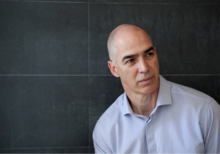
Arthur Bowen Davies was an avant-garde American artist and influential advocate of modern art in the United States c. 1910–1928.

The Chazen Museum of Art is an art museum located at the University of Wisconsin–Madison in Madison, Wisconsin. The Chazen Museum of Art is accredited by the American Alliance of Museums.

The David and Alfred Smart Museum of Art is an art museum located on the campus of the University of Chicago in Chicago, Illinois. The permanent collection has over 15,000 objects. Admission is free and open to the public.
Sylvia Plimack Mangold is an American artist, painter, printmaker, and pastelist. She is known for her representational depictions of interiors and landscapes. She is the mother of film director/screenwriter James Mangold and musician Andrew Mangold.
Hollis Sigler was an American artist. She received several Arts Lifetime Achievement awards as both an artist and an educator, including the Distinguished Artist Award for Lifetime Achievement from the College Art Association in 2001.

Martha Hopkins Struever (1931–2017) was an American Indian art dealer, author, and leading scholar on historic and contemporary Pueblo Indian pottery and Pueblo and Navajo Indian jewelry. In June 2015, a new gallery in the Wheelwright Museum of the American Indian, was named for her. The first permanent museum gallery devoted to Native American jewelry, the Martha Hopkins Struever Gallery, is part of the Center for the Study of Southwestern Jewelry.
Roland Conrad Petersen is a Danish-born American painter, printmaker, and professor. His career spans over 50 years, primarily in the San Francisco Bay Area and is perhaps best-known for his "Picnic series" beginning in 1959 to today. He is part of the Bay Area Figurative Movement.
Robert Amft was a painter, sculptor, photographer, designer born in Chicago.
Tom Torluemke is an Indiana-based, contemporary American artist. His practice spans 30 years and includes works in painting, drawing, sculpture and installations in a variety of mediums. He is known for his powerful, no holds barred approach to subject matter relating to socio-political, ethical and humanistic themes.
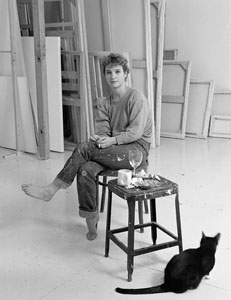
Louisa Lizbeth Chase was an American neo-expressionist painter and printmaker.

Phyllis Bramson is an American artist, based in Chicago and known for "richly ornamental, excessive and decadent" paintings described as walking a tightrope between "edginess and eroticism." She combines eclectic influences, such as kitsch culture, Rococo art and Orientalism, in juxtapositions of fantastical figures, decorative patterns and objects, and pastoral landscapes that affirm the pleasures and follies of romantic desire, imagination and looking. Bramson shares tendencies with the Chicago Imagists and broader Chicago tradition of surreal representation in her use of expressionist figuration, vernacular culture, bright color, and sexual imagery. Curator Lynne Warren wrote of her 30-year retrospective at the Chicago Cultural Center, "Bramson passionately paints from her center, so uniquely shaped in her formative years […] her lovely colors, fluttery, vignette compositions, and flowery and cartoony imagery create works that are really like no one else's. Writer Miranda McClintic said that Bramson's works "incorporate the passionate complexity of eastern mythology, the sexual innuendos of soap operas and sometimes the happy endings of cartoons."

Sylvia Fein was an American surrealist painter and author. Inspired by the quattrocento, Fein painted in egg tempera, which she made herself. She studied painting at the University of Wisconsin–Madison, where she became part of a group of magical realist painters, including Gertrude Abercrombie, Marshall Glasier, John Wilde, Dudley Huppler, and Karl Priebe. A newspaper described her as "Wisconsin’s Foremost Woman Painter." Beginning in the 1940s, Fein lived for a time in Mexico, then in the San Francisco Bay Area of California, eventually settling in the town of Martinez. Her 100th birthday was marked with an exhibition at her alma mater, The University of California at Berkeley.
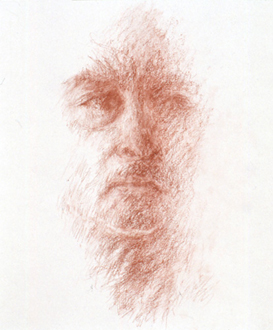
Arthur Lerner is an American artist, known for his atmospheric figurative paintings and drawings, landscapes, and still lifes. He is sometimes described as a realist, but most critics observe that his work is more subjective than descriptive or literal. Associated with Chicago's influential "Monster Roster" artists early in his career, he shared their enthusiasm for expressive figuration, fantasy and mythology, and their existential outlook, but diverged increasingly in his classical formal concerns and more detached temperament. Critics frequently note in Lerner's art a sense of light that evokes Impressionism, delicate color and modelling that "flirts with dematerialization," and the draftsmanship that serves as a foundation for all of his work. The Chicago Tribune's Alan Artner lamented Lerner's comparative lack of recognition in relation to the Chicago Imagists as the fate of "an aesthete in a town dominated by tenpenny fantasts." Lerner's work has been extensively covered in publications, featured in books such as Monster Roster: Existential Art in Postwar Chicago, and acquired by public and private collections, including those of the Smithsonian Institution, Art Institute of Chicago, Smart Museum of Art, and Mary and Leigh Block Museum of Art, among many.

Rodney Carswell is an American abstract artist. He first gained recognition for human-scaled, geometric paintings that feature exposed, projected support structures, creating interplay between sculptural presence and richly painted pictorial surfaces. His recent paintings eschew the superstructures and evoke a greater sense of immediacy, playfulness, and narrative. Critics often describe Carswell's work as uncanny, elusive or quirky, for its tendency to negotiate "in-between" spaces and embrace contradictions such as order and instability, intention and accident, or back and front. Employing irregularly shaped canvasses, thick supports, and openings or holes that reveal the stretcher construction and walls behind them, works like 3 (1994) often occupy a place between painting and sculpture. In a similar way, Carswell uses the modernist languages of Minimalism, Suprematism and Constructivism, yet eludes those categories with postmodern allusions to architecture, the body and spiritual iconography, and with his process-oriented, "hand-made" surfaces. In his essay for Carswell's mid-career retrospective at Chicago's Renaissance Society, Los Angeles Times critic David Pagel suggested that his understated paintings worked their way into one's consciousness in a "supple, somewhat unsettling manner" that achieves a subtle, but lingering shift in perception.
Jan Cicero Gallery was a contemporary art gallery founded and directed by Jan Cicero, which operated from 1974 to 2003, with locations in Evanston and Chicago, Illinois and Telluride, Colorado. The gallery was noted for its early, exclusive focus on Chicago abstract artists at a time when they were largely neglected, its role in introducing Native American artists to mainstream art venues beyond the Southwest, and its showcasing of late-career and young women artists. The gallery focused on painting, and to a lesser degree, works on paper, often running counter to the city's prevailing art currents. It was also notable as a pioneer of two burgeoning Chicago gallery districts, the West Hubbard Street alternative corridor of the 1970s, and the River North district in the 1980s.

Helen O'Toole is an Irish-born painter based in the United States, who is known for abstract paintings suggestive of landscape. She has exhibited throughout Ireland and the United States, in Singapore, and at venues including the San Francisco Museum of Modern Art, Portland Art Museum, Chicago Cultural Center, Tacoma Art Museum, and Institute of Contemporary Arts Singapore. Her work has been featured in the journals Artforum, Arts Magazine, New Art Examiner, and Zyzzyva, as well as the Chicago Tribune,The Irish Times, Seattle Post-Intelligencer, and National Public Radio. Art writers frequently discuss the interplay in her work between abstraction, the evocation of otherworldly light, land and space, and a commitment to investigating meaning through a painting process akin to the processes of cultivation and excavation. Artforum critic James Yood wrote, "echoing the often inchoate quality of nature, her paint surges toward mystery and hints at a kind of chiaroscuro of the spirit"; curator Bonnie Laing-Malcomson suggests her "richly colored monumental paintings evoke the moody landscape of her rural Irish homeland, summoning the force of J. M. W. Turner and Mark Rothko." She has been recognized with a Guggenheim Fellowship in Fine Arts, a Contemporary Northwest Art Award, and a Pollock-Krasner Foundation Award (2013), among other awards. O'Toole lives in Seattle, Washington and is Professor of Art and Chair of the Painting and Drawing Program at the University of Washington.

Frank Piatek is an American artist, known for abstract, illusionistic paintings of tubular forms and three-dimensional works exploring spirituality, cultural memory and the creative process. Piatek emerged in the mid-1960s, among a group of Chicago artists exploring various types of organic abstraction that shared qualities with the Chicago Imagists; his work, however relies more on suggestion than expressionistic representation. In Art in Chicago 1945-1995, the Museum of Contemporary Art, Chicago (MCA) described Piatek as playing “a crucial role in the development and refinement of abstract painting in Chicago" with carefully rendered, biomorphic compositions that illustrate the dialectical relationship between Chicago's idiosyncratic abstract and figurative styles. Piatek's work has been exhibited at institutions including the Whitney Museum, Art Institute of Chicago, MCA Chicago, National Museum, Szczecin in Poland, and Terra Museum of American Art; it belongs to the public art collections of the Art Institute of Chicago and MCA Chicago, among others. Curator Lynne Warren describes Piatek as "the quintessential Chicago artist—a highly individualistic, introspective outsider" who has developed a "unique and deeply felt world view from an artistically isolated vantage point." Piatek lives and works in Chicago with his wife, painter and SAIC professor Judith Geichman, and has taught at the School of the Art Institute of Chicago since 1974.
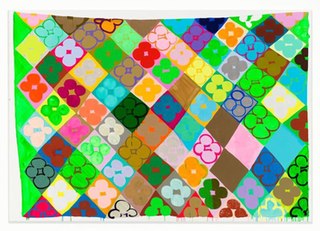
Judy Ledgerwood is an American abstract painter and educator, who has been based in Chicago. Her work confronts fundamental, historical and contemporary issues in abstract painting within a largely high-modernist vocabulary that she often complicates and subverts. Ledgerwood stages traditionally feminine-coded elements—cosmetic and décor-related colors, references to ornamental and craft traditions—on a scale associated with so-called "heroic" abstraction; critics suggest her work enacts an upending or "domestication" of modernist male authority that opens the tradition to allusions to female sexuality, design, glamour and pop culture. Critic John Yau writes, "In Ledgerwood’s paintings the viewer encounters elements of humor, instances of surprise, celebrations of female sexuality, forms of vulgar tactility, and intense and unpredictable combinations of color. There is nothing formulaic about her approach."

Neil Goodman is an American sculptor and educator, known for bronze works that combine elegant arrangements and forms with hand-wrought, textured surfaces. He has explored a wide range of formats—still-life compositions, wall and floor installations, free-standing works and monumental public art—in a formalist style that has evolved from spare representation to abstraction and minimalism.
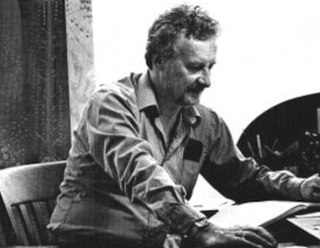
Richard Loving (1924–2021) was an American artist and educator, primarily based in Chicago, Illinois. He gained recognition in the 1980s as a member of the "Allusive Abstractionists," an informal group of Chicago painters, whose individual forms of organic abstraction embraced evocative imagery and metaphor, counter to the dominant minimalist mode. He is most known for paintings that critics describe as metaphysical and visionary, which move fluidly between abstraction and representation, personalized symbolism taking organic and geometric forms, and chaos and order. They are often characterized by bright patterns of dotted lines and dashes, enigmatic spatial fields, and an illuminated quality. In 2010, critic James Yood wrote that Loving's work "mull[ed] over the possibilities of pattern and representation, of narrative and allegory" to attain a kind of wisdom, transcendence and acknowledgement of universals, "seeking understanding of self within the poetics of the physical world."
